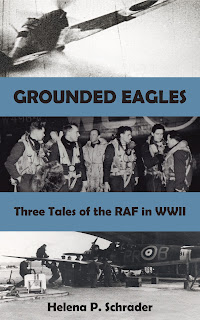The Crew - Wireless Operator/Signaller
It
took a team to fly a bomber in WWII and the wireless operator served as the vital link between the aircraft and its base, other aircraft and rescue services.
The limitations of airborne communications systems combined with the need for radio silence to the extent possible meant that in practice pilots very rarely communicated by radio either with other aircraft or with the ground. Instead, wireless communications, which could be more easily encrypted, were used to the extent possible. As with so many other aircrew trades, wireless operators were also initially expected to man one of the guns. With the introduction of dedicated gunners later in the war, however, the wireless operator was "freed" to focus on all aspects of communication from the intercom to the wireless, but also including signalling, i.e. aldis lamp and firing flares. Due to his training, the wireless operator was often expected to be able to repair any electronic system on board -- or at least give it a try.
Wireless operators, therefore, needed to be bright and good with "gadgets." First and foremost, however, they needed to master morse code, that is to read and send at a rate of at least 22 words a minute. They were also expected to master radar, aircraft recognition, and to navigate using radio signals. A RAF signaler remembers learning to navigate as follows.
We navigated our way around Britain by obtaining bearings from ground stations situated all over the country -- each one with its individual call sign. We developed the knack of distinguishing where a call was coming from by the note of the morse signal. No two stations sounded exactly the same, just as each operator had a slightly different rhythm when tapping out a message. We progressed from the conscious, deliberate approach to an instinctive level where sending and receiving became second nature. We communicated in morse as in speech, no longer hampered by an awareness of the technique. It was remarkable how adept we became at winkling out faint, distant signals, although they were almost obliterated by crackling static and overriding 'mush.' [Bruce Lewis, Aircrew: The Story of the Men who Flew the (Bombers. Cassell Military. 1991) 125]
In consequence of the high demands on wireless operators, the training was long, roughly two years including training at operational and heavy conversion units. The wash-out rate was also high. Much like pilot training, less than a third of the candidates who started training actually qualified.
Once flying operations, the wireless operators were primarily responsible for maintaining "contact" with the ground through the air waves. The wireless operators both received orders and weather advisories from Bomber Command and sent out information such as updates on wind and weather, and, most importantly, an SOS in the event of an emergency. One of the most important duties of the wireless operator was obtaining position fixes in bad weather when other forms of navigation were not reliable. All too often, rain and fog closed in over England while the bombers were out over the Continent. When they returned, after five, six or more hours of being buffeted about and relying heavily on dead reckoning, they often had only a vague idea of where they were. If Gee was working, the navigator could use that to fix the aircraft's position, but it was often the wireless operator's ability to identify the beacons of the many stations and get a bearing that enabled an aircraft to land safely.
Some wireless operators, designated as "Special Operators," however, had a different task. These were fluent German speakers who used airborne transmitters to try to interfere with the instructions set from ground control to airborne German night fighters.
My novels
about the RAF in WWII are intended as tributes to the men in the air and
on the ground that made a victory in Europe against fascism possible. The wireless operator of Kit Moran's Lancaster is an important secondary character in Moral Fibre.
Riding the icy, moonlit sky,
they took the war to Hitler.
Their chances of survival were less than fifty percent.
Their average age was 21.
This is the story of just one bomber pilot, his crew and the woman he loved.
It is intended as a tribute to them all.
or Barnes and Noble.

"Where Eagles Never Flew" was the the winner of a Hemingway Award for 20th Century Wartime Fiction and a Maincrest Media Award for Military Fiction. Find out more at: https://crossseaspress.com/where-eagles-never-flew
For more information about all my aviation books visit: https://www.helenapschrader.com/aviation.html






Comments
Post a Comment